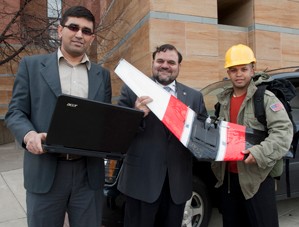
UC Aerial Robot System Can Save Firefighter Lives
Wildfires kill and, too often, fatalities are caused by a lack of situational awareness, said Kelly Cohen. Timely information can prevent wildfire deaths, especially among first responders, said Cohen, associate professor of aerospace engineering & engineering mechanics at the University of Cincinnati.
Cohen supervises a project known as SIERRA (Surveillance for Intelligent Emergency Response Robotic Aircraft) which integrates small, unmanned aircraft with global positioning systems, environmental data, video and fire-prediction software to give real-time information about where a fire is burning, and where it is moving.
What we are designing is a complete system, Cohen said. It is low-cost and low-risk. That is important for this application because, while the technology is ready, firefighters are not quick to adopt new technologies. We can show that this works.
To gain the confidence of working firefighters, the graduate student who serves as SIERRA team leader, Robert Charvat, participated in firefighter training in West Virginia.
The SIERRA team tested the system in Coopers Rock State Forest, West Virginia, with a small, contained fire on Nov. 5, 2011, in collaboration with the West Virginia Division of Forestry. The UC team present at this test included five graduate students and three undergraduates who experienced a valuable day of learning away from the classroom and labs.
This test was a clear demonstration of the potential for this technology to limit wild land fire damage by saving money, lives and land, Charvat said.
The SIERRA system, Cohen said, is designed to assist firefighters overcome a major handicap during a wildfire the inability to see the whole fire. Wildfires not only burn through rugged terrain marked by hills and valleys but, even on relatively level ground, obscure their extent by screens of smoke.
If I am coordinating response efforts, Cohen said, I require information to determine what resources I need, where I must deploy those resources, and where I must be ready to move. This system uses the information gathered and allocates resources.
The SIERRA system is built around a small, unmanned aerial vehicle from Marcus UAV Inc. The five-pound vehicle has a 54-inch wingspan and the ability to fly faster than 35 miles per hour to altitudes of 10,000 feet on flights lasting approximately an hour. While in the air, the vehicle can transmit video while it navigates using GPS.
For our purposes, the vehicle flew no higher than 500 feet, Cohen said. It was a successful demonstration of tactical unmanned aerial system technology for use in wild land fire events.

Rob Charvat prepares the robot plane.
At the fire command center, the in-flight data is merged with Google Earth images, NOAA weather data and fire-prediction software to make informed and effective decisions by the incident commander.
Although the West Virginia demonstration focused on firefighting, the integrated system Cohen has developed along with Manish Kumar of UCs Cooperative Distributed Systems Lab, has applications beyond wildfire response.
A similar decision-making need arises in many disasters, Cohen said, including floods and earthquakes.
The system can even be modified for use for simulation based training for first responders.
As we execute this work, Cohen said. We are continually reviewing additional areas in which our unmanned aerial vehicle based systems and algorithms may provide a benefit. One such area is air traffic management while effectively integrating unmanned aerial vehicles into the national airspace.

SIERRA Team at the test burn site.
Support for the SIERRA project was provided by NASA through the Ohio Space Grant Consortium with the University of Cincinnati providing more than 50 percent of the cost share.
Related Stories
First cohort of Doctor of Nursing Practice in public health...
April 4, 2025
In a couple of weeks, University of Cincinnati (UC) students will celebrate a meaningful achievement as they graduate across various fields, ready to make significant contributions in their respective professions. Among them is the UC College of Nursing’s first cohort of Doctor of Nursing Practice-prepared public health nurses, who will begin a new professional chapter leading efforts to improve health outcomes, reduce disparities and advocate for healthier communities.
Living in Cincinnati: Why the Queen City is a great place to...
Discover what makes life in Cincinnati special! From top attractions to local favorites, explore why the Queen City is a great place to live, work, and play.
OTR mural celebrates UC alumni success
April 4, 2025
The UC Alumni Association, UCAA, will mark its annual Alumni Celebration during its upcoming Alumni Week, April 7-13, with a community art project commemorating this year’s slate of alumni honorees receiving the organization’s top awards.
